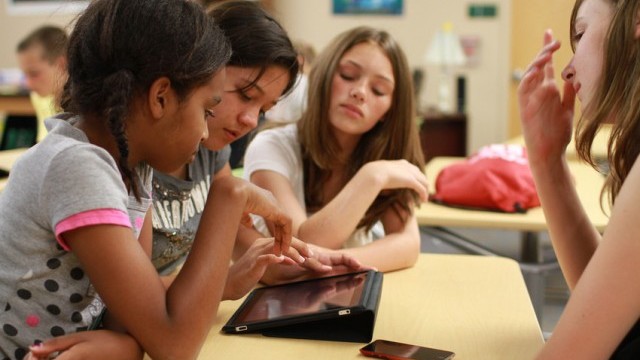
Although many people worry that game-based learning will lead to an increasingly standardized pedagogy, the best implementations do the exact opposite. They make differentiated instruction easier and more efficient. Teachers can use games as a supplement that enables increased one-on-one learning between teacher and student.
I visited one kindergarten classroom where ST Math was part of the curriculum. The kids called it Jiji math because of the adorable animated penguin. Jiji the penguin is not only the ST Math mascot, but also a critical part of the program’s pedagogy. Created by the MIND Research Institute, ST (spatial temporal) Math offers a playful game-based program that teaches mathematical concepts without using words.
ST Math has all the bells and whistles of cutting-edge software but it is not revolutionary. That is, despite being digital, it remains grounded in three classic principles of good teaching: interactivity, informative feedback, and intrinsic motivation. I spoke to the company’s founder, Dr. Matthew Peterson, to understand how these three principles work in practice.
1. Interactivity. Learning needs to be a dialogue. The child needs to come before the curriculum. At the same time, learning needs to be interactive because, as Dr. Peterson explains, “they need to own their own solutions." That's why multiple choice doesn’t work; it puts assessment before learning. If the student doesn’t generate his or her own answers, the quality of retention is severely debilitated.
2. Informative feedback. Obviously video games and computer software offer substantially more opportunities for interactivity than the old fashioned textbook, or even the supplemental workbooks. But the majority of educational games are simply electronic tests with animated gold stars and smiley faces.They lack informative feedback, which is different from simple rewards because it is transformational rather than transactional. Unlike points and grades, which simply tell students whether they're right or wrong, informative feedback provides instant explanations about why an answer is right or wrong. ST Math uses Jiji to provide informative feedback. When the answer is right the penguin can move across the screen; when it's wrong, he can’t.
3. Intrinsic motivation. When informative feedback works, students are no longer motivated by transactional rewards. Instead, they are intrinsically motivated to solve the problems, not to pass the test. Dr. Peterson explains this using the example of the Rubik’s Cube. The classic puzzle toy has nothing to do with gold stars, nor smiley faces, nor coins. Instead, one twists the cube because of the pure intrinsic pleasure you get from seeing all the colors line up.
ST Math combines instruction, practice, and assessment so that they're always happening simultaneously, and it can be used even in classrooms with few computers. In the kindergarten classroom I visited, there were only four laptops. They were set up at a table near the “cozy corner.” This was just one station in a room full of math themed choices. There were manipulatives at another table. Worksheets and art supplies at others.
The students were lively. Some were following instructions with the manipulatives. Some were tracing numbers on worksheets. Some were drawing number-themed pictures. And some were playing “Jiji Math” at the table of laptop computers.
So how does the teacher incorporate the games into the curriculum? “Video games allow me to keep some students working on academic content while I give other students personal attention,” said Lisa Pack, the classroom teacher. She made her rounds, moving from one station to another, giving focused attention to each student that wasn’t working with Jiji. Then, after 15 or 20 minutes, she rotated some students off Jiji and moved others on. She immediately worked with the students who had been working with Jiji and then she continued to make rounds of the room. Sometimes she worked directly with groups of students, other times with individuals.
It was clear that she knew exactly what each student needed and was able to provide it in an individual way. ST Math was like a classroom assistant. It wasn’t doing the teaching, but rather reinforcing the concepts that had already been taught. The games were classroom management tools, providing engaging practice for some students while she worked with others. They enabled more personalized face-to-face instruction by making it more efficient.
In many of the classrooms I visit, digital games are being used in the same way. They're just one activity in a room full of diverse learning options. When thinking about game-based learning, we don’t always have to imagine the games at the center of the classroom. The games can belong on the margins, supplementing everyday teaching practices and providing the tools that enable differentiated instruction.


